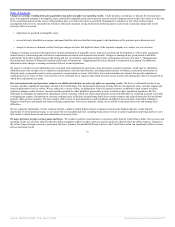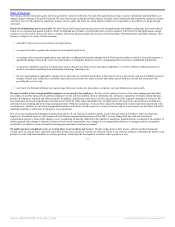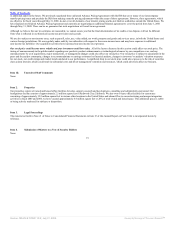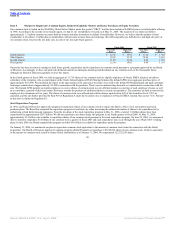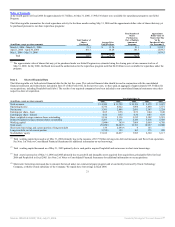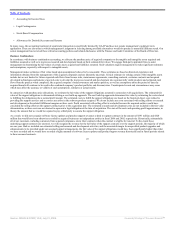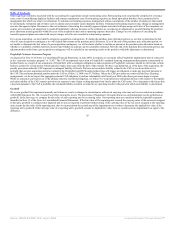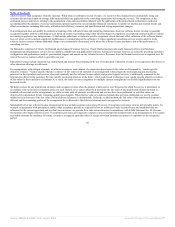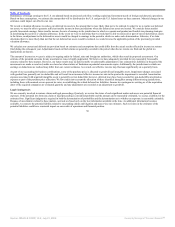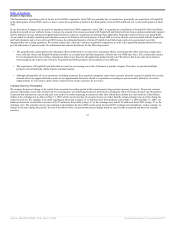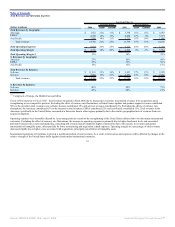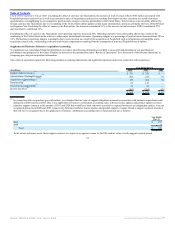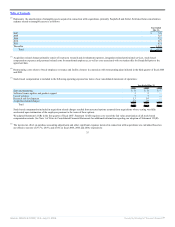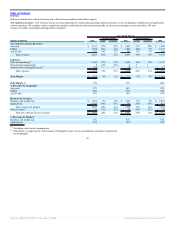Oracle 2005 Annual Report Download - page 29
Download and view the complete annual report
Please find page 29 of the 2005 Oracle annual report below. You can navigate through the pages in the report by either clicking on the pages listed below, or by using the keyword search tool below to find specific information within the annual report.
Table of Contents
Other significant estimates associated with the accounting for acquisitions include restructuring costs. Restructuring costs are primarily comprised of severance
costs, costs of consolidating duplicate facilities and contract termination costs. Restructuring expenses are based upon plans that have been committed to by
management but which are subject to refinement. To estimate restructuring expenses, management utilizes assumptions of the number of employees that would
be involuntarily terminated and of future costs to operate and eventually vacate duplicate facilities. Estimated restructuring expenses may change as management
executes the approved plan. Decreases to the cost estimates of executing the currently approved plans associated with pre-merger activities of the companies we
acquire are recorded as an adjustment to goodwill indefinitely, whereas increases to the estimates are recorded as an adjustment to goodwill during the purchase
price allocation period (generally within one year of the acquisition date) and as operating expenses thereafter. Changes in cost estimates of executing the
currently approved plans associated with our pre-merger activities are recorded in restructuring expenses.
For a given acquisition, we may identify certain pre-acquisition contingencies. If, during the purchase price allocation period, we are able to determine the fair
value of a pre-acquisition contingency, we will include that amount in the purchase price allocation. If, as of the end of the purchase price allocation period, we
are unable to determine the fair value of a pre-acquisition contingency, we will evaluate whether to include an amount in the purchase price allocation based on
whether it is probable a liability had been incurred and whether an amount can be reasonably estimated. After the end of the purchase price allocation period, any
adjustment that results from a pre-acquisition contingency will be included in our operating results in the period in which the adjustment is determined.
PeopleSoft Customer Assurance Program
As discussed in Note 16 of Notes to Consolidated Financial Statements, in June 2003, in response to our tender offer, PeopleSoft implemented what it referred to
as the “customer assurance program” or “CAP.” The CAP incorporated a provision in PeopleSoft’s standard licensing arrangement that purports contractually to
burden Oracle, as a result of our acquisition of PeopleSoft, with a contingent obligation to make payments to PeopleSoft customers should we fail to take certain
business actions for a fixed period, which typically expires four years from the date of the contract. We have concluded that, as of the date of the acquisition, the
penalty provisions under the CAP represent a contingent liability of Oracle. We have not recorded a liability related to the CAP, as we do not believe it is
probable that our post-acquisition activities related to the PeopleSoft and JD Edwards product lines will trigger an obligation to make any payment pursuant to
the CAP. The maximum potential penalty under the CAP as of May 31, 2006 was $3.5 billion. Unless the CAP provisions are removed from these licensing
arrangements, we do not expect the aggregate potential CAP obligation to decline substantially until fiscal year 2008 when these provisions begin to expire.
While no assurance can be given as to the ultimate outcome of potential litigation, we believe we would also have substantial defenses with respect to the legality
and enforceability of the CAP contract provisions in response to any claims seeking payment from Oracle under the CAP terms. If we determine in the future that
a payment pursuant to the CAP is probable, the estimated liability would be recorded in our operating results in the period in which such liability is determined.
Goodwill
We review goodwill for impairment annually and whenever events or changes in circumstances indicate its carrying value may not be recoverable in accordance
with FASB Statement No. 142, Goodwill and Other Intangible Assets. The provisions of Statement 142 require that a two-step impairment test be performed on
goodwill. In the first step, we compare the fair value of each reporting unit to its carrying value. Our reporting units are consistent with the reportable segments
identified in Note 15 of the Notes to Consolidated Financial Statements. If the fair value of the reporting unit exceeds the carrying value of the net assets assigned
to that unit, goodwill is considered not impaired and we are not required to perform further testing. If the carrying value of the net assets assigned to the reporting
unit exceeds the fair value of the reporting unit, then we must perform the second step of the impairment test in order to determine the implied fair value of the
reporting unit’s goodwill. If the carrying value of a reporting unit’s goodwill exceeds its implied fair value, then we would record an impairment loss equal to the
difference.
26
Source: ORACLE CORP, 10-K, July 21, 2006 Powered by Morningstar® Document Research℠


